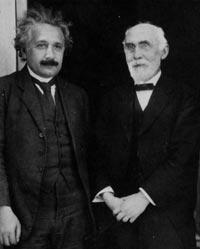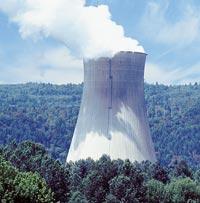Relativity, the special theory that accelerated physics

Matter and energy are the same, said Albert Einstein himself. Planets, mountains, seas, animals, trees and we are energy because we are matter. The truth is that Einstein did not use those words exactly, but a much more representative phrase: "It followed from the special theory of relativity that mass and energy are both but different manifestations of the same thing". That is, matter and energy are different forms of the same. And, more important than words, Einstein left us a formula to express that idea: E = mc 2 . He published his famous formula in his particular theory of relativity.
In addition to indicating that matter and energy are the same, Einstein's formula determines the proportion between the two. In short, the formula says that a little matter equals a lot of energy. And the other way around. It would take a lot of energy to get some matter, as long as we knew how to transform it with each other. Somehow, matter is a "frozen" energy, or something like that. Curious concept. Where did the young man working in a patent office get that idea?
Many times we have been told that it was a matter of inspiration, that is, that Einstein was going to be bored at work, that he was going to have his head on something else and, as he was a genius, the idea of relativity came to him. It cannot be said that Einstein was not a very intelligent young man, but the theory of relativity had not "come" to him without more. He had serious problems developing this theory.
The special theory of relativity, moreover, does not arise from a single idea. It is based, at least, on two principles, the so-called relativity and the idea that the speed of light is constant. Both were published in 1905, but they were not improvisations. They were long-thought-provoking ideas.
Relativity itself
Perhaps the easiest thing to understand is the relativity of both principles. The principle of relativity states that physical laws within an inertial system do not vary depending on the speed of the system. They are fat words, but easy to understand.

Inertial systems are called those that have a constant speed and do not accelerate. For example, someone on the street is in an inertial system, because the street has no acceleration, because it is still. If an earthquake occurred, it would have acceleration, but if not, the street is still. However, it is not necessary for the system to stand to be inertial. A constant speed train is also an inertial system.
The principle of relativity states that physical laws are not modified within an inertial system. It doesn't matter if you're on the street or traveling on a train that moves a hundred kilometers per hour, the physical laws are the same.
An example widely used by physicists is easily visible. Imagine that you are inside a train that goes a hundred kilometers per hour (it is surprising that the example of the train used to explain relativity! ) and you drop an apple (the apple is also classic in the examples of physics, right? ). The apple falls vertically to the ground, as if it had dropped it in the season. Physical law does not change. The apple falls in the same way both inside the train and in the station.
It seems obvious, right? Was that the fascinating idea of relativity? For it is not so evident: the fact itself does not look the same from another point of view. Now you are at the station and you have seen the train pass. And at that moment someone who goes on the train has dropped the apple. You, from the station, will not see the apple fall vertically. Due to the speed of the train, during the fall it will move a few meters forward and, for you, the apple will make a parable when falling. The above image shows this parable.

From these two points of view we have collected two versions of the same event. So what has really happened? The principle of relativity says that one cannot say what is the 'real' version and what is not. Both are real and not the only truth. For there to be only one truth we should have an absolute reference, but it does not exist.
In order to determine speeds, for example, we would need a stationary reference. But what? Soil? It is a good reference to study the movement of the train, but it is not suitable, for example, to study the Moon. So what? The Earth? The sun? The milky way? In the universe there is nothing standing and there are no absolute references.
Speed of light
Hence the importance of the principle of relativity, which highlights the dependence of the reference system. From there Einstein left to deduce the famous formula E = mc 2, but not only from there.
He also used the second principle that the speed of light is absolute. Absolute means, regardless of the reference, that it is always the same. It is difficult to understand. It does not conform to what instinct tells us, and that is why we are so difficult to understand it. In fact, the simple measure of the speed of light becomes very strange, although it is a very old question.
When Einstein was born, scientists had very well measured the speed of light. In 1676, Danish Ole Römer said the light travels 225,000 kilometers in a second. The measurement was good, not far from the value allowed today
The number is minimal. Measuring this speed means recognizing that light does not suddenly appear everywhere, but moves. And so it has a speed.

It is believed that the speed of light and any other speed should act the same way, but it is not so. Physicists use the train and the station to explain it, and this time the person at the station has a brush. If switched on, the light spreads at full speed, 300,000 kilometers per second. With this there is no problem. The problem arises when measured from the moving train. If the train travels at a speed of 200,000 kilometers per second, the speed of light should be 100,000 in the same sense of the train, but it is not the result of the measurement; both from the station and from the train, the speed of light is 300,000 kilometers per second.
How is it possible? The point is that speed changes several factors. One of them is the length of the moving object, of the train, in our example. Only by speed, the train compresses in the direction of movement. And the faster it moves, the more it compresses. Precisely at the speed of light would disappear. So why don't we perceive it? Just because we move too slowly. The fastest spacecraft is also too slow to feel compression. In fact, the 1% compression would require moving to 42,300 kilometers per second, that is, to 152 million kilometers per hour. No doubt, current technology cannot cause this type of speed in a container.
In our example the train is compressed, but the interiors are not. However, due to compression, results of 300,000 kilometers per second are achieved. Measured from any reference system, the speed of light is the same.
Background
Einstein's idea is not that speed produces compression. For his part, the Irish FitzGerald and the Dutch Lorentz proposed this proposal and launched formulas to calculate compression. It was a new and daring concept, but it perfectly explained a famous experiment by two American physicists: Michelson and Morley measured the speed of light taking into account the motion of the Earth. According to them, as the Earth was moving, the speed of light could not be the same in the direction of motion and perpendicular to that direction. But whenever they were measured, the speed of light was the same. The experiment seemed an absolute failure, but in the long run it was a very useful failure, for some the most prolific failure in the history of science (perhaps to say too much). FitzGerald and Lorentz started from this failure to propose that speed produces compression.

And Einstein collected and generalized all these convictions and calculations on the basis that the speed of light is absolute. Lorentz considered that with speed the mass increases in the case of charged particles; Einstein considers that the mass increases with speed in any type of matter, not only in charged particles. Also, time was not absolute either, but it depended on reference, that is, on a clock that moves at high speed time slows down. This has a surprising consequence: that simultaneous events do not necessarily occur simultaneously from a different speed reference system. This has a great influence on astronomical observation, for example.
From there, the path to formula E = mc 2 is in the field of mathematical operations and basic physics (it is easy to say, but you have to). Based on Lorentz's formulas and considering that the speed of light is absolute, Einstein deduced the relationship between mass and kinetic energy. That formula has become very popular, but not so much its meaning. That matter and energy are the same. And what? The special theory of relativity has the appearance of a simple theoretical occurrence, but it is the basis of the atomic bomb, and that does.
New physics
These ideas of the special theory of relativity are not easily understood, among other things because we live in a very slow life. We do not move at high speed and, except for the light itself, we do not see anything that moves at high speed.

out there, we must take into account the theory of relativity,
since the particles move at high speed.
Otherwise, it would be clear that the speed of light is absolute, it does not depend on the reference point. That is not relative. And that is one of the foundations of the theory of relativity. It seems a paradox, but it does not create a real paradox.
However, this theory acquired great fame: it was difficult to understand, complex and, above all, useless. What is the theory of what moves so fast if nothing moves so fast in our environment? Stay. Electrons, protons and many particles move quickly. Very fast. And electricity is an electron movement, and to understand everything that happens in particle accelerators, relativity must be taken into account. It is not an empty issue. In fact, relativity changed physics and, together with physics, technology.
Fission, daughter of relativity

Matter and energy are the same. That is what the theory of relativity says. If we knew how to convert mass into energy, it would be an inexhaustible source. But we do not know this process. We are not able to 'extract' all the energy that encloses matter. The atomic bomb and other nuclear reactions are the best approaches so far. In these reactions, energy becomes a few particles, a very small mass for each core of uranium that breaks, and this process releases an enormous amount of energy. Capable of producing an atomic bomb. Imagine what energy would be like if uranium atoms were transformed whole. If 92 protons with Uranium-235 isotopes, 92 electrons and 143 neutrons became energy, today there would be no Hiroshima. And perhaps a nuclear power plant meant enough energy for the whole planet.
General Theory of Relativity

As for relativity, Einstein did not remain in the ideas published in 1905. In short, these ideas only explained the physics of systems at constant speed. In 1916 he generalized the theory and explained, among other things, the origin of gravity. He explained that the large masses distort space and time and that gravity is a consequence of it. The higher the mass, the more it distorts space and time and creates a greater gravity field around.
The orbit of the planet Mercury is understood with this theory. The orbit is rare, not a pure ellipse. But Einstein explained that this was due to the Sun. The Sun has a large mass and Mercury is very close. There the consequences of general relativity are necessarily appreciated.





